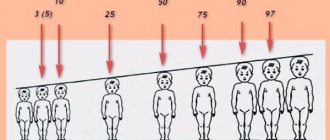Active growth
Usually girls begin to actively grow at the age of 9-10 years. In this case, the peak growth rate occurs at 11-12 years, which coincides with intensive sexual development. In boys, active growth begins a little later (about 11 years) and reaches its maximum by 13 years. This is why in high school girls are taller than boys at first, and then this changes.
During a growth spurt, guys normally manage to grow by 9-10 cm per year, and girls - by 7-8 cm per year. This explains the fact that men are usually 10-12 cm taller than women. The growth rate slows down towards the end of puberty. This is due to the fact that the growth of cartilage, which is located at the ends of long tubular bones, practically stops.
Growth - norms and pathology in premature babies
In premature infants, it is necessary to determine the correspondence of physical development to the gestational age. Development corresponds to gestational age when assigning weight, body length, head circumference, weight-height coefficient from the 10th to the 90th percentile.
Intrauterine growth retardation is diagnosed with consistently low indicators with two or more measurements below the 3rd percentile - with height less than 48 cm, weight less than 2200 g.
All children with intrauterine growth retardation must be observed by a pediatric endocrinologist.
After 43 weeks, assessment of physical development is carried out according to charts for young children, but taking into account the corrected age (the difference between the actual postnatal age in weeks and the weeks of gestation missing to full term).
The highest growth rates of premature babies are in the first 3 months of life (3.5-5 cm per month).
- In the first half of the year, the monthly increase in height is 2.5-5.5 cm,
- in the second half of the year - 0.5-3 cm.
The total increase in height for the year is 27-38 cm.
The average height of a newborn child by year is 70.2-77.5 cm.
The body weight of premature babies in the 1st year increases 6-7 times; an increase of 20 g/kg body weight at birth is adequate. Anthropometric indicators are equal to those of full-term children aged approximately 2 years, but with a body weight of up to 1500 g. indicators are lagging behind.
How to get taller
A healthy, nutritious diet, regular exercise, and good, adequate sleep help achieve maximum growth. Most children do not need to take any additional nutritional supplements because all essential nutrients are obtained from food.
You should be wary of any products that promise to make you taller. In some pharmacies you can find tablets whose labels say “growth stimulant” or “growth hormone”, but growth hormone is a medicine that should not be taken without a doctor’s prescription.
Sometimes a doctor may prescribe such a drug, but only for strict medical reasons, such as proven severe growth hormone deficiency. HGH has certain side effects: it can cause diabetes and fluid buildup in the brain (hydrocephalus).
The Problem of Tall Teens
It is not uncommon for one student in high school to stand out for his large height compared to other classmates. The reasons for this phenomenon may be the following factors:
- Heredity - most often, if a boy or girl has one of the parents who is tall, then this is passed on to the child
- Klinefelter syndrome
- High production of growth hormones
- Acromegaly
- Early maturation of adolescents
- Marfan disease
- Excessive fat mass
The tallest girl is seventeen years old
A reason for concern for parents may be that their child is much shorter than his peers. So, the reasons that a teenager is not growing much or has stopped growing altogether may come from the following sources:
- Genes - no wonder short parents have small children
- Various pathologies - only doctors can diagnose them
- Lack of vitamins in the body of a teenager
- Bad habits (smoking, alcohol, drugs, unhealthy lifestyle)
Bad habits affect the growth of teenagers
Smoking has a negative impact on the normal development of adolescents
Is it possible to predict growth?
The best way to predict growth is to draw up and carefully study the so-called growth chart or graph. The pediatrician notes on the graph the age and height of the child at a given time and monitors its changes. Since doctors know very well how boys and girls should grow, it will not be difficult for them to assess these parameters.
Future growth can also be calculated mathematically. But to do this, you must know the height of both parents, since the main parameters of the body depend 90% on genes. There are several formulas that allow you to roughly estimate the height of an adult. For example:
- Girls' height = (mother's height + father's height - 17) / 2
- Boys' height = (mother's height + father's height + 17) / 2
You can use a special calculator that allows you to calculate your child’s height online.
Child's weight
Below you can see the indicators of a child’s body weight depending on age (from 2 to 10 years), tables compiled by WHO in 2006.
During visits to the pediatrician, your child will be weighed, height, and other measurements taken. Weighings are performed on gram-accurate scales. A baby up to one year old is weighed naked to accurately determine his weight.
Weigh-ins let you know how your little one is gaining weight, and you can compare your little one's performance to the average child weight. Each baby develops differently, the most important thing is steady growth.
Vitamins for children under 1 year of age
"Multi-tabs Baby" drops
Vitamins replenish vitamins A, D, C. The principle of action is characterized by the properties of vitamins.
Contraindication for use: hypersensitivity to one of the components.
Side effect: allergic reaction.
The drug is taken orally, during and after meals, 1 ml per day or as prescribed by a doctor. The duration of use is also determined by the doctor.
Approximate cost 294 rubles.
Biovital gel for children
Action:
- normalizes metabolism;
- increases immunity;
- compensates for the missing amount of vitamin.
It is not recommended for use in case of hypervitaminosis A, D, excess calcium levels in the body, or hypersensitivity to one of the components.
Dosage: 0.5 tsp. 2-3 times a day, the duration of use is determined by the doctor.
Overdose: nausea, stomach upset.
Approximate cost 300 rubles.
Vitamins for children from 3 to 7 years old
Complivit Calcium D3
Action: regulates the exchange of calcium and phosphorus.
Contraindications: tuberculosis, hypervitaminosis, increased calcium levels in the body.
Side effects: abdominal pain, nausea, diarrhea, allergic reactions.
Dose: 1-2 tablets per day.
Approximate cost 350 rub.
Vitamins Calcium Plus
Action: enriches the body with calcium, phosphorus and vitamin D, strengthens bones and teeth, prevents caries. An allergic reaction is possible.
Dosage: 2 lozenges 2 times a day with food.
Approximate cost 560 rub.
Vitrum Baby
Action: increases immunity, promotes better development of the child. It is not recommended to take if you have hypervitaminosis A, D, or hypersensitivity to the components of the drug.
Dose: 1 tablet per day after meals.
Approximate cost 300 rubles.
Vitamins that are needed for the growth of a child and their importance for growth and development
If a child is not growing well, he may lack vitamins:
- Vitamin A. One of the most important vitamins for growth, taking part in bone synthesis. Contained in fish oil, dairy products, liver.
- Vitamin D. Helps to better absorb calcium and phosphorus. Promotes strong bones and teeth. A remedy against rickets. To get enough of this vitamin, you need to eat milk, liver, fish, eggs and walk in sunny weather. Read what vitamin D supplements infants can take in a separate review.
- B vitamins. Improve digestion, metabolism, structure and strengthen bones. Can be found in oatmeal, meat, dairy products, avocados, nuts, eggs, especially quail eggs.
- Vitamin C. Helps vitamins A, D, E be better absorbed, but does not itself promote bone growth. The vitamin is found in large quantities in citrus fruits and cabbage.
- Vitamin K. Affects bone health. Found in green leafy vegetables.
You always need to be careful with vitamins to prevent hypervitaminosis.
It is not always possible to get the necessary vitamins from food. Sometimes it is simply necessary to add pharmaceutical drugs during periods of vitamin deficiency. There are a number of vitamin preparations for children for growth and development.
Vitamins for growth for children from 1 year to 3 years
Pikovit
Action: replenishes the deficiency of vitamin A, B, C, D.
It is not recommended for use in case of hypervitaminosis A, D, diabetes mellitus, or hypersensitivity to the components of the drug. Allergic reactions are possible.
Dosage: 1 tsp. 2 times a day.
Approximate cost 324 rubles.
Sana-Sol
Action: replenishes vitamin deficiency, improves digestion. Allergic reactions are possible.
Dosage: 1 tsp. in a day.
Approximate cost 1205 rub.
Multi-tabs
Action: replenishes vitamin deficiencies. There are complexes for all ages, so you can drink with the whole family during periods of vitamin deficiency, for example in the spring.
Side effects: an allergic reaction is possible.
Dosage: 1 tablet per day.
Approximate cost 380 rubles.
Vitamins for the growth of children 12 years and older
Elkar
Action: improving metabolism, reducing excess weight, increasing energy. An allergic reaction is possible.
Dose: from 1 to 4.5 measuring spoons (divided into 2-3 doses).
Approximate cost 500 rub.
Revital Calcium D3
Action: improves metabolism, strengthens bones. It is not recommended to take if there is a large amount of calcium in the body, or if you are hypersensitive to the components of the drug.
Dose: 1 tablet 2 times a day orally with food, chew the tablet.
Approximate cost 200 rubles.
What influences the lag/advancement of physical development
When monitoring a child's development, pediatricians pay attention to child growth charts.
It is important to monitor the dynamics of the child’s development and record data to compare them with the norm
Normal limits are set within 25%, 50%, 75%, but if the development dynamics are within 3% and 97%, that is, very low and very high, respectively, but this may signal the presence of pathology.
But often children with such indicators develop just as normally as those with indicators of 25%, 50%, 75%.
Everyone’s body is individual, and the growth dynamics of children are different for everyone. If in one month of life the child has not grown as indicated in the table, then there is no need to worry in advance.
The pediatrician, first of all, will look at the growth of the parents and ask how quickly they grew in childhood, since the genetic information embedded in the child manifests itself.
With the onset of puberty, intensive development begins . The time at which maturation began influences physical development. This is due to the released hormones.
If puberty is premature, then the child will stop growing before the age of 18, but if it began late, then the person will lag behind his peers in development, but the opportunity to catch up with them is great.
Growth hormones are produced by the pituitary gland - an endocrine gland . A lack of growth hormone in the body is called hypopituitarism. Consequently, growth slows down in this condition.
Another important hormone is thyroxine, which is secreted by the thyroid gland. The lack of this hormone leads to slower growth and development in general. This disease is called hypothyroidism. Many chronic diseases can also slow development.
An important factor is the way the mother behaved during pregnancy. Alcohol, smoking, and poor nutrition negatively affect the development of the fetus, as a result of which the child may be born premature.
Developmental delay is characterized by genetic diseases. For example, a disease where girls grow very slowly is called Turner syndrome . Marfan syndrome is characterized by tall height, long arms and legs.
The child's short stature is also due to lack of food. In order for a child to grow well, he needs to receive all the necessary substances and microelements.
It is important for every parent to know how their child is developing, what the norms are for the weight and height of children under one year old. What time do children start walking? Practical advice for parents can be found here. How to cope with your beloved children if they are hyperactive? Read in this material.










